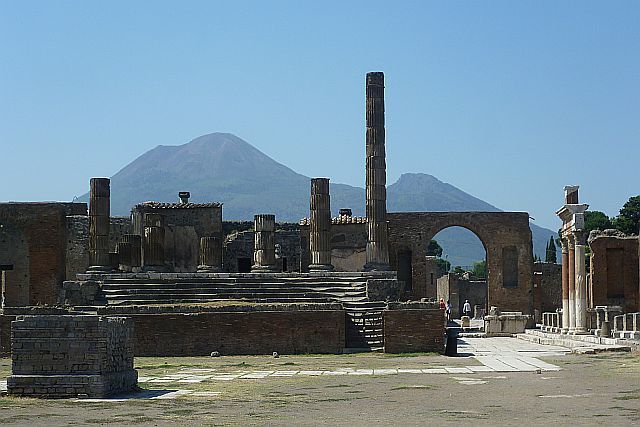During the First Century, war and illnesses were common killers in the Roman Empire. However, in the year 79 CE, Mount Vesuvius would show the city of Pompeii that a natural disaster could bring as much devastation and destruction as anything else.
In the decades before Mount Vesuvius engulfed Pompeii in ashes, an earthquake had struck the region. While the earthquake did not devastate the region, people there did not comprehend the amount of death and destruction that a natural disaster was capable of. In 79 CE, the beautiful and thriving city of Pompeii in the Roman Empire was a popular location for the wealthy and merchants to flock to. Historians have placed the population of Pompeii and neighboring region between 10,000 and 20,000 people. 1 Unfortunately, in the month of August, the city of Pompeii would be transformed from a jewel to ruins by one of the most powerful and devastating natural forces: a volcanic eruption.

Although nature provided warning signs of the catastrophic event that would soon follow, people were not able to comprehend them. Animals were dying because of their lungs being filled with toxic gas, a strong odor filled the countryside of Pompeii, and worse of all, earthquakes rattled the ground below as a result of the pressure from the magma.
On the morning of August 24, 79 CE, a strong blast from Mount Vesuvius that resulted in smoke arising from the crater drew people’s attention to the volcano, but the people of Pompeii did not panic or evacuate. Worse was yet to come. Around noon, the second explosion took place. This explosion was much stronger. A mushroom cloud shot into the sky at a distance of 27 miles. The explosion was estimated to be 100,000 times stronger than the bomb dropped on Hiroshima.2
The eruption that caused the mushroom cloud was so strong that it could have been witnessed hundreds of miles away. Pliny the Younger, an eyewitness, was so horrified and amazed by the cloud that he could not help but describe it in awe:
A cloud, from which mountain was uncertain, at this distance (but it was found afterwards to come from Mount Vesuvius), was ascending, the appearance of which I cannot give you a more exact description of than by likening it to that of a pine-tree, for it shot up to a great height in the form of a very tall trunk, which spread itself out at the top into a sort of branch.3
For those who decided not to flee Pompeii in the wake of the eruption, death was almost certain. As the eruption lasted a day, every passing hour meant more ash and toxic gas. If somehow people managed to survive breathing the toxic gas, the volcanic ashes were sure to kill them. Since structures in Pompeii were not built to carry as much weight as the ash covering them, many structures collapsed, resulting in the deaths of people who found refuge in them.
By the time Mount Vesuvius stopped ejecting ash and toxic gas into the air, ash covered Pompeii. The entire city of Pompeii was gone. What once was a vibrant city was reduced to a pile of ash. In fact, to this day a third of the city remains in ash. Although Mount Vesuvius has not erupted since 1944, an eruption is imminent; hopefully the destruction of the next eruption will not be as severe as the one in 79 CE.
- Encyclopedia Britannica, September 2016, s.v. “Pompeii Ancient City, Italy,” by Wilhelmia Feemster Jashemski. ↵
- Encyclopedia Britannica, September 2016, s.v. “Pompeii Ancient City, Italy,” by Wilhelmia Feemster Jashemski. ↵
- Charles W. Eloit, The Harvard Classics Volume 9 (New York: P.F. Collier & Son. 1909-10), 285. ↵


68 comments
Maria Callejas
Great intro! It clearly emphasizes the lethal impact Mount Vesuvius had on Pompeii. Great usage of factful information. Specifically, when you describe how animals were dying because of the volcanic gases, rather than from eruptions. This shows the highly dangerous nature of volcanoes. Nevertheless, Mount Vesuvius showed it’s full power. And you made this incredibly clear when you said: “the explosion was estimated to be 100,000 times stronger than the bomb dropped on Hiroshima”. Also, using the words of an eyewitness gives a sense of validity to your text. Awesome work!
Oceane Roux
Thank you for this article! It’s amazing what a natural disaster can do. I always thought that the destruction of Pompeii was due to lava and no toxic gas, so thank you for correcting me! It’s crazy that people at the time decided to stay in the city. It’s sad to think it was all due to the lack of information they had at the time.
Zeresh Haman
I have always found the story of Pompeii to be a really interesting, I never really understood how no one really panicked after the first eruption. I think even the earthquakes would’ve been enough to freak me out. I think it is really cool that the ash has preserved part of the city, its an unfortunate story, but we still have real evidence of what happened all those years ago. I really enjoyed reading this article.
Veronica Spryszynski
Never knew that Pompeii still existed today. Great informative article! The volcano looks massive in your photo above. I think people should’ve started evacuating once they saw the fumes and ashes coming out of the volcano especially when they start to see animals dying from it first. So unfortunate that we lost many ancient artifacts due the the ashes. The 1944 eruption tustve been frightening.
Mario Sosa
During this time period, it must have been impossible to imagine having an entire city buried in volcanic ash. I really liked how you included an eye-witness description of the eruption. A lot of us, myself included, have heard of how the city of Pompeii was wiped out, but I was surprised of how much stronger the explosion was compared to the Hiroshima atomic bomb, not to mention that the volcano can still erupt to this very day. This is quite a fascinating article, superb job!
Blanca Martinez
I know quite a bit about the Pompeii disaster and you got most of the information from this event in this article, which is very nice. I liked the way you described most things, there was missing information, I’m not going to lie, but it wasn’t exactly missing so much that it made the article too vague. There was enough information to know just how bad the natural disaster was towards Pompeii and how in a way they went into extinction from a volcano. I quite liked your article, thank you for writing it.
Tyler Sleeter
Great article. Natural disasters have always interested me because they can have such a dramatic effect on history and the environment. (Just ask the dinosaurs.) I like how this article points out that there were many warning signs that an eruption was imminent, but very few people were aware of the danger. It is saddening to know that so many people died because humans were not educated about the dangers of volcanoes at that time in history. It is probably a good idea that people like Pliny the Younger were able to record the events as they witnessed them so that we have a record of the horror that happened at Pompeii.
Valeria Hernandez
The article is too broad; it does not include much information about the population or a specific concern that arose from the eruption. Yesenia Cardenas should have included more information regarding the population mortality, damage done, and the geographical results. In other words, Cardenas should have focused on the post or aftermath of the catastrophe. However, Cardenas picked an interesting topic especially because of current environmental concerns.
Tara Sellers
This article explains that the people of Pompeii did not understand that they were in danger of a natural disaster. Even with different warning signs they still did nothing. I would have liked the article to have gone more in depth in the actual destruction of the town. Maybe talk about the ruins that have been found and how we have casts of people in their last moments. In all the paper was good.
Joel Gracia
This is a great article that peaks the readers interest from the beginning. In the past, I had thought that the volcanic eruption of Pompeii was just so abrupt and swift that it took all the citizens by surprise, but it never occurred to me that an impending eruption was staring them in the face. I am thankful that we now have the knowledge that we need to avoid disasters like these.